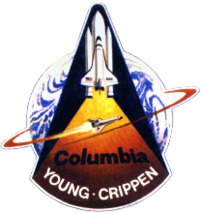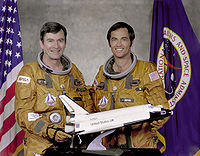STS-1
| STS-1 | |||||
Mission insignia |
|||||
| Mission statistics | |||||
|---|---|---|---|---|---|
| Mission name | STS-1 | ||||
| Space Shuttle | Columbia | ||||
| Crew size | 2 | ||||
| Launch pad | 39-A | ||||
| Launch date | April 12 1981 12:00:03 UTC | ||||
| Landing | April 14 1981 18:20:57 UTC Edwards AFB, Runway 23 |
||||
| Mission duration | 2d/6:20:53 | ||||
| Number of orbits | 37 | ||||
| Orbital altitude | 307 km | ||||
| Orbital inclination | 40.3 degrees | ||||
| Distance traveled | 1.728 million km | ||||
Crew photo Crew members John W. Young and Robert L. Crippen pose in ejection escape suits (EES) with small model of the space shuttle. |
|||||
| Related missions | |||||
|
|||||
The first Space Shuttle mission, STS (Space Transportation System)-1, was launched April 12 1981, and returned April 14. Space Shuttle Columbia orbited the earth 37 times in this 54.5-hour mission. It was the first US manned space flight since the Apollo-Soyuz Test Project on July 15 1975.
All Space Shuttle flights are referenced by their sequential chronological number, prefaced by the acronym "STS", which stands for "Space Transportation System", which is the proper way to refer to the collective parts of the Space Shuttle technologies used together.
Contents |
Crew
Number in parentheses indicates number of spaceflights by each individual prior to and including this mission.
- John W. Young (5) - Commander
- Robert Crippen (1) - Pilot
Backup crew
- Joe Engle - Commander
- Richard Truly - Pilot
Mission parameters
- Mass:
- Orbiter Liftoff: 219,256 lb (99,453 kg)
- Orbiter Landing: 195,466 lb (88,662 kg)
- DFI payload: 10,822 lb (4,909 kg)
- Perigee: 149 mi (240 km)
- Apogee: 156 mi (251 km)
- Inclination: 40.3°
- Period: 89.4 min
Mission highlights
The first launch of the Space Shuttle occurred on April 12, 1981, exactly 20 years after the first manned space flight, when the orbiter Columbia, with two crew members, astronauts John W. Young, commander, and Robert L. Crippen, pilot, lifted off from Pad A, Launch Complex 39, at the Kennedy Space Center — the first of 24 launches from Pad A. It was exactly 7 a.m. EST. A launch attempt 2 days earlier was scrubbed because of a timing problem in one of the Columbia’s general purpose computers.
Not only was this the first launch of the Space Shuttle, but it marked the first time that solid fuel rockets were used for a U.S. manned launch. It was also the first U.S. manned space vehicle launched without an unmanned powered test flight. The STS-1 orbiter, Columbia, also holds the record for the amount of time spent in the Orbiter Processing Facility (OPF) before launch — 610 days, time needed for replacement of many of its heat shield tiles.
Primary mission objectives of the maiden flight were to check out the overall Shuttle system, accomplish a safe ascent into orbit and to return to Earth for a safe landing. All of these objectives were met successfully, and the Shuttle's worthiness as a space vehicle was verified.
The STS-1 Shuttle reached an orbital altitude of 166 nautical miles.
The only payload carried on the mission was a Development Flight Instrumentation (DFI) package which contained sensors and measuring devices to record orbiter performance and the stresses that occurred during launch, ascent, orbital flight, descent and landing.
The 37-orbit, 1,074,567-mile-long flight lasted 2 days, 6 hours, 20 minutes and 53 seconds. Landing took place on Runway 23 at Edwards Air Force Base, California on April 14 at 10:21 a.m. PST. [1]
Columbia was returned to Kennedy Space Center from California on April 28 atop its 747 carrier aircraft.
Mission anomalies
STS-1 was the first test flight of what was, at the time, probably the most complex spacecraft ever built. There were numerous problems – 'anomalies' in NASA parlance – on the flight, as many systems could not be adequately tested on the ground or independently. Some of the more serious or interesting were:
- According to Space.com, STS1 was the only Shuttle to launch after T-0.
- During reentry, a protruding tile gap filler ducted hot gas into the right main landing gear well, which caused significant damage including buckling of the landing gear door.[2] Also, a tile next to the right-hand External Tank (ET) door on the underside of the shuttle was incorrectly installed, leading to excessive re-entry heating and melting of part of the ET door latch.
- Inspection by astronauts while in orbit showed significant damage to the thermal protection tiles on the OMS/RCS pods at the orbiter aft end, and John Young reported that two tiles on the nose looked like someone took 'big bites out of them'.[3] Post-flight inspection of Columbia's heat shield revealed that an overpressure wave from the Solid Rocket Booster (SRB) ignition resulted in the loss of 16 tiles and damage to 148 others.
- The same overpressure wave pushed the body flap below the main engines at the rear of the shuttle well past the point where damage to the hydraulic system would be expected, which would have made a safe re-entry impossible. The crew were unaware of this until after the flight, and John Young reportedly said that if they had been aware of the potential damage at the time, they would have flown the shuttle up to a safe altitude and ejected. Columbia would have been lost on the first flight.[4]
- Bob Crippen reported that all through the first stage of the launch up to SRB separation, he saw 'white stuff' coming off the External Tank and splattering the windows, which was probably the white paint covering the ET thermal foam.[5]
- Columbia's aerodynamics at high Mach number were found to differ significantly in some respects from those estimated in pre-flight testing. A misprediction of the location of the center of pressure (due to using an ideal gas model instead of a real gas model) caused the computer to extend the body flap by sixteen degrees rather than the expected eight or nine, and side-slip during the first bank reversal maneuver was twice as high as predicted.[6]
Despite these problems, STS-1 was a successful test, and in most respects Columbia came through with flying colors. After some modifications to the shuttle and to the launch and re-entry procedures, Columbia would fly the next four Shuttle missions.
Mission insignia
The artwork for the official mission insignia was designed by artist Robert McCall. It is a symbolic representation of the shuttle. The image does not depict the black wing roots present on the actual shuttle.
Anniversary

Yuri's Night is an international celebration held on April 12 every year to commemorate the first human in space and the first Space Shuttle launch.
In tribute to the 25th anniversary of the first flight of Space Shuttle, Firing Room 1 in the Launch Control Center at Kennedy Space Center was renamed to the Young-Crippen Firing Room, dedicating the firing room that launched the historic flight and the crew of STS-1.
NASA described the mission as: "The boldest test flight in history" [1].
External tank
STS-1 was one of only two shuttle flights to have its External Tank (ET) painted white. In an effort to reduce the Shuttle's overall weight STS-3 and all subsequent missions used an unpainted tank, which translated into a weight savings of approximately 272 kg / 600 pounds.[7] This lack of paint gives the ET its distinctive orange color now associated with the Space Shuttle.
Rejected test
At one stage, NASA considered making STS-1 a test of the Return to Launch Site (RTLS) abort profile, which would have required Columbia to jettison the Solid Rocket Boosters at the normal separation altitude, fly downrange and pitch the Orbiter and External Tank over, resulting in the vehicle flying backwards with all three engines burning at the same time. Because the RTLS maneuver is considered very risky, Young declined, saying, "Let's not practice Russian roulette."[8]
Cultural references
The song "Countdown" by Rush from the 1982 album Signals was written about STS-1 and the inaugural Space Shuttle flight of Columbia. The song was "dedicated with thanks to astronauts Young and Crippen and all the people of NASA for their inspiration and cooperation". The song "Red Sector A" from their 1984 album Grace Under Pressure was named for the area where the band witnessed the launch.
Hail Columbia!
IMAX cameras filmed the launch, landing, and mission control during the flight for a film entitled Hail Columbia!, which debuted in 1982. It is now available on DVD. The title of the film comes from the pre-1930s unofficial American national anthem, also titled Hail, Columbia.
Gallery
See also
- Space science
- Space shuttle thermal protection system
- List of space shuttle missions
- List of human spaceflights chronologically
References
- ↑ STS-1 Overview
- ↑ Space Review
- ↑ STS-1 Technical Crew Debriefing, page 4-4
- ↑ Quoted by James Oberg
- ↑ STS-1 Technical Crew Debriefing, page 4-4
- ↑ Kenneth Iliff and Mary Shafer, Space Shuttle Hypersonic Aerodynamic and Aerothermodynamic Flight Research and the Comparison to Ground Test Results, Page 5-6
- ↑ National Aeronautics and Space Administration "NASA Takes Delivery of 100th Space Shuttle External Tank." Press Release 99-193. 16 Aug 1999.
- ↑ Popular Mechanics, Astronauts in Danger'', December 2000
External links
- The launch of STS-1 (Google Video)
- NASA PAO page about STS-1
- STS-1 Mission Report for STS-1
- STS-1 Video Highlights
- STS-1 Anomaly Report
- Hail Columbia! at the Internet Movie Database
|
||||||||
|
|||||||||||||||||